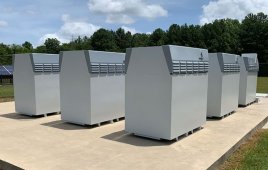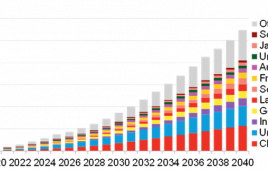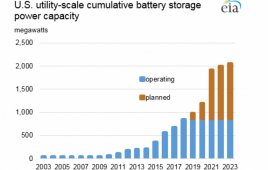Editor’s note: Large scale and economic power storage will be a great boon to the renewable energy industry. EVs will benefit, utilities will benefit, and ideally, the wind industry will respond with greater production to keep those batteries charged with clean power.
A recent report from Navigant Research examines the market for automotive advanced batteries, providing global forecasts for capacity and revenue, segmented by vehicle powertrain and region, through 2026.
Sales of electric vehicles (EVs) are increasing rapidly as battery costs decline and mileage ranges rise. While early hybrid vehicles featured nickel-metal hydride (NiMH) batteries almost exclusively, lithium ion (Li-ion) has now taken precedence, particularly in battery electric vehicles (BEVs) and plug-in hybrid EVs (PHEVs). According to a new report from the research firm, advanced battery energy capacity for automotive applications is expected to increase from 125 GWh in 2017 to 568 GWh in 2026, representing a compound annual growth rate of 18.3%.
“Volumetric energy density and longer battery life are the most important properties to consider as new advanced battery technical developments and design parameters are pursued,” says Ian McClenny, research analyst with Navigant Research. “Greater energy density remains desirable, but not at the expense of reduced service life.”
According to the report, there are various Li-ion battery chemistries in the marketplace, with no single chemistry standing out as the right energy storage solution for all vehicles. Additionally, battery manufacturers are using all types of cell formats across the industry—established manufacturers tend to favor large format cells like prismatic or pouch, while newer battery startups favor cylindrical cells.
The report, Market Data: Advanced Energy Storage for Automotive Applications, provides a detailed examination of the growing market for automotive advanced batteries, including assessments of EV roadmaps, battery manufacturers, and vehicle OEMs. The study assesses the battery markets for different vehicle types, as well as projected sales for BEVs, PHEVs, and HEVs. Global market forecasts for capacity and revenue from automotive advanced batteries, segmented by vehicle powertrain and region, extend through 2026. The report also includes a review of the different Li-ion battery chemistries and competing energy storage technologies, such as advanced lead-acid batteries, NiMH batteries, and ultracapacitors. An Executive Summary of the report is available for free download on the Navigant Research website.
Navigant Research, the research arm of Navigant, provides market research and benchmarking services for rapidly changing and often highly regulated industries. In the energy sector, Navigant Research focuses on in-depth analysis and reporting about global clean technology markets.
Filed Under: Energy storage




